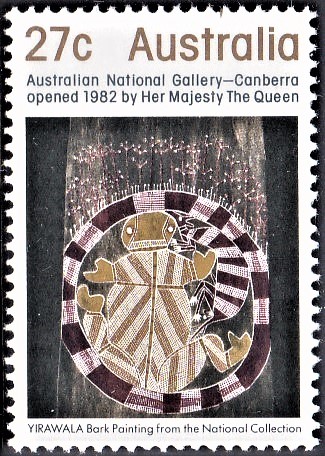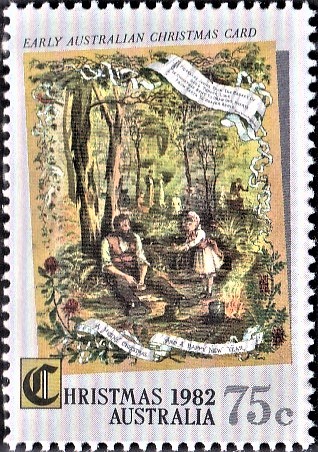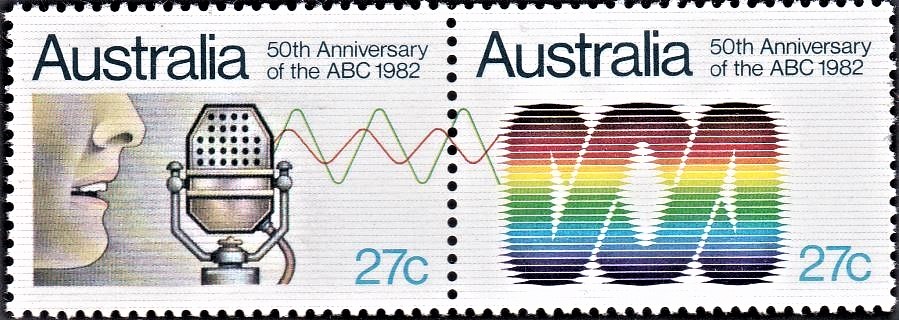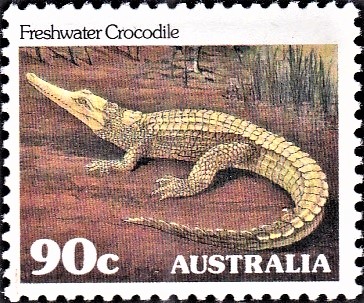
Australian National Gallery – Canberra
A commemorative postage stamp on the Australian National Gallery, Canberra, opened in 1982 by Her Majesty The Queen :
 Issued by Australia
Issued by Australia
Issued on Oct 12, 1982
Issued for : The commemorative stamp issued by Australia Post for the opening of the Australian National Gallery reproduces a bark painting by the Aboriginal artist Yirawala, from the Gallery’s collection. The illustration on the first day cover, shown above, is a painting of the exterior of the Gallery by a member of Australia Post’s Graphic Design Section.
Design : The bark painting by Yirawala selected for the stamp commemorating the opening of the Australian National Gallery is one of a series illustrating the legend of Gurgurr, the moon man. Gurgurr and his dog, Mulutji, dug for water while travelling inland during the Dreamtime. The flood of water released by their efforts became the river now known as the Liverpool River. Gurgurr and his dog were trapped in the water, but because they had brought forth a great river their reflections went to the moon, and remain there still.
Yirawala, an elder of the Gunwinggu tribe, was the first traditional bark painter to gain fame in his own lifetime. He was born near the Maningrida settlement in approximately 1896, and started painting on bark when over the age of 50. In the traditional styles of western Arnhem Land, he depicted the Great Spirit ancestors of the Dream time, totemic objects and animals, and the sacred symbols of rituals and ceremonies.
In 1971, Yirawala was appointed an MBE and was awarded the International Art Co-operation prize. In that same year he became the first traditional Aboriginal artist to have an exhibition entirely devoted to his own work. His paintings now hang in art galleries and museums in Europe and North America. His wish that his work become part of a national collection for all Australians to enjoy, has in part come to fruition with the location of a significant collection of his paintings in the Australian National Gallery. Yirawala died in 1976, on Croker Island. A copyright fee has been paid to the Aboriginal Artists’ Agency, Sydney, agents for Yirawala‘s estate.
Designer : Australia Post Graphic Design Section from a painting by Yirawala [Australia Post’s Graphic Design Section is involved in much of the illustrative, photographic, typographic and graphic design work of publications, posters and many other projects produced at Australia Post Headquarters. The Graphic Design Section is also responsible for many of the designs which have appeared on pre-stamped envelopes. In 1982 the Graphic Design Section was responsible for the design concept of the ‘Australian National Gallery – Canberra’ stamp, the typography of the ‘Eucalypts‘ stamps, and first day covers including ‘National Stamp Week 1982‘, ‘Christmas 1982‘, and ‘Aboriginal Culture: Music and Dance’. First day cover illustrations are reproduced in this album above the text describing stamp issues.]
Type : Stamp, Mint Condition
Colour : Multi colour
Denomination : 27 Cent
Stamp size : 26 mm x 37.5 mm
Perforation : 14½ x 14½
Paper : APWH stamp paper
Sheet content : 100 (issued)
Printing process : photolithography on a four–colour Roland Rekord press
Printer : Leigh–Mardon Pty Limited, Melbourne
About :
- An architectural competition was held in 1968 for the Australian National Gallery building. The winning design was by Colin Madigan, of Edwards, Madigan, Torzillo & Briggs International Pty Ltd. The final design for the Gallery was approved by the federal government in 1971, and construction was commenced in 1974 by the National Capital Development Commission.
- The Australian National Gallery occupies a two hectare site in what is known as the Parliamentary Triangle; the other two buildings in the Triangle are the recently completed High Court, also designed by Colin Madigan, and the future Parliament House.
- The Gallery is multi-level with bush-hammered concrete walls, and quarry tile, slate and timber floors. The eleven exhibition galleries occupy one third of the total floor space on three levels. Other areas open to the public include an education department with lecture and activity rooms, two theatres, and a restaurant tower.
- According to the provisions of the National Gallery Act 1975, the Australian National Gallery is a corporate body established to house the national collection of works of art in the Australian Capital Territory. The Gallery is administered by a Council of not more than eleven members, appointed by the Governor-General. The Council’s executive officer is the Director of the Australian National Gallery.
- The first priority is the completion of the national collection of Australian art, encompassing the fine and applied arts, architecture and design, and the decorative arts. A core collection of 700-800 works is envisaged, with regular changes in the display of 400 exhibits. The national collection of Australian art is aimed at being comprehensive, and the focal point of the Gallery.
- Other collections are expected to complement existing public collections, and to reflect Australia’s geographical and cultural position. That is, due attention will be given to the arts of the south-east Asian and Pacific regions, while acknowledging that Australia‘s cultural heritage has its origins in Europe. Select examples of the finest available works will be acquired in the following areas: the arts of Asia and south-east Asia; primitive art; European art before 1850; art of the modern period, from 1850; prints, drawings and illustrated books from 1800; sculpture; decorative arts; photography; and film.






